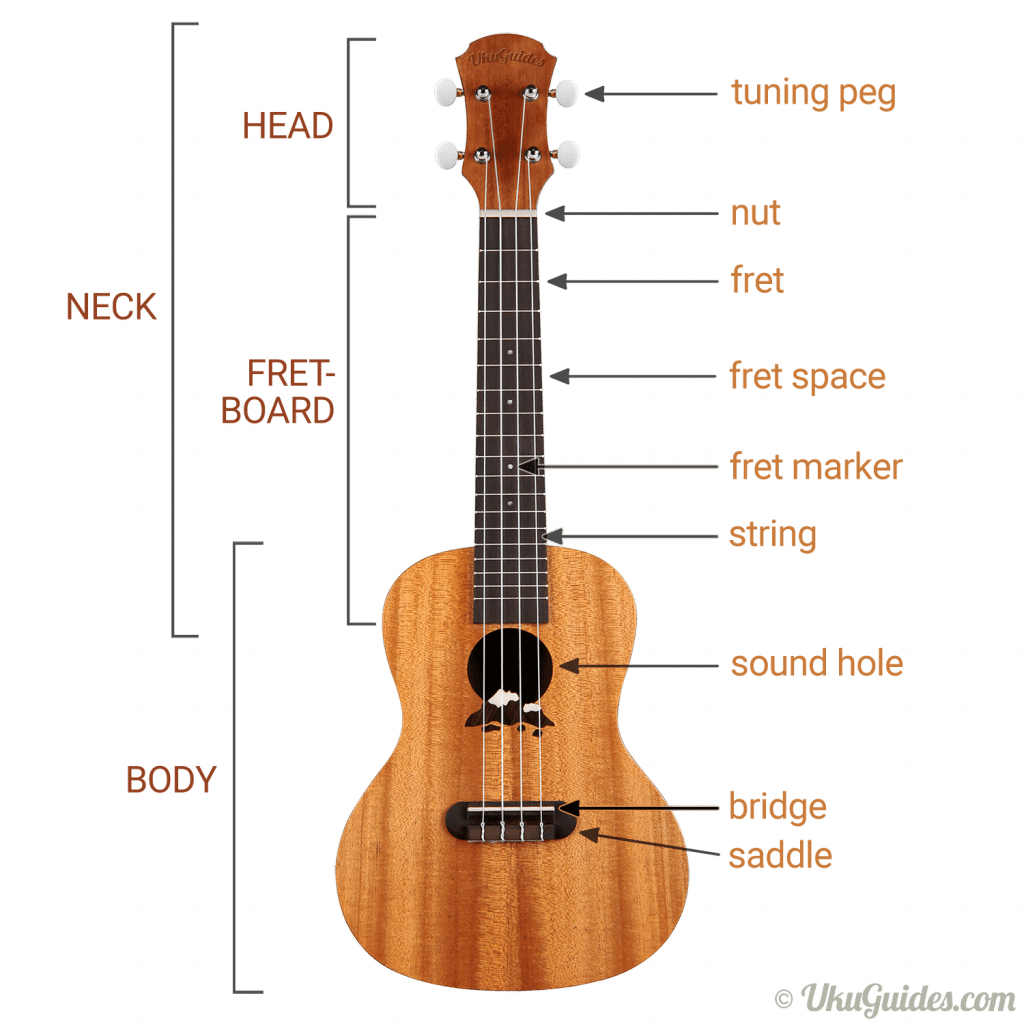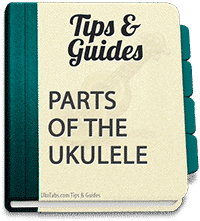Knowing the different parts of a ukulele can become quite handy when you are talking to other people about the instrument. It’s also useful when you need a spare part. In this brief guide I will explain all the main parts of a ukulele.

Parts of a ukulele in one handy list
Body
The main part of a ukulele. The body consists of a back, top and sides. This is where the choice of wood can be very important to create a sound that is warm, crisp or full. The wood will be either laminated or solid. Typical woods used for ukulele are mahogany, koa, rosewood and spruce. The body may include a cutaway or scallop in order to reach the higher frets on the fretboard.
Sound Hole
The sound hole is an opening in the top of the body just underneath the strings to let the vibrations created by the strings out. It projects the sound that reverberates inside the body of the ukulele. Strumming or plucking the strings directly above the sound hole produces the loudest sound, whereas moving away from the sound hole up the neck or down the body reduces the sound. Some sound holes have a pattern inlaid into the wood surrounding them called a rosette.
Bridge, lower part of a ukulele
The bridge is mounted on the top of the body of the ukulele just below the sound hole and holds the saddle. The bridge is where you will secure the strings at the body of the ukulele, usually done by knotting one end of the string.
Saddle
The saddle sits on top op the bridge and is needed to hold all the strings in place at the body of the ukulele (like the nut at the neck). It keeps the strings at a proper distance above the fretboard (= action).
Headstock, upper part of a ukulele
This is the top of the ukulele that the tuning pegs are attached to. The brand logo is usually found on the headstock or head and there might be a serial number on the back of it. A headstock can be solid or slotted which seems to be a matter of aesthetic preference with no detectable effect on the ukulele’s tone.
Tuning pegs
Also referred to as tuning keys, tuning heads and machine heads. These are the parts that hold the strings. By twisting (rotating) them, you can tune your ukulele.
Nut
The nut keeps the ukulele strings in the correct positions over the fretboard. Along with the saddle at the body it has small notches that hold the strings in their proper place at the neck.
Neck
The neck is a sturdy piece of wood that supports the fretboard and connects the headstock to the body. It is curved to allow hands to cup the neck comfortably. The neck and headstock are usually made of one solid piece of wood to give it strength to support the tension of the strings. Typically made out of the same wood as the body.
Fretboard
On the fretboard you can find all the… frets! The first fret is the one nearest the headstock. You press the strings against the fretboard to create a note or chord when playing the ukulele. Fretboards are usually made from rosewood. More high-end ukuleles might feature an ebony fretboard.
Fret markers
These parts of a ukulele are usually dots, but on custom or limited (i.e. expensive) models, they might be more artistic. They are there to make your life easier, so that you see quickly where you are playing. They are usually positioned at the fifth, seventh, tenth and twelfth fret. Sometimes you can also find fret markers on the side of the neck.
Frets
The actual frets are those metal “bars” that run vertically up and down the fretboard. The frets mark the different pitches of notes.
Fret space
The fret space is where you press the strings against the fretboard so the strings lay against the fret in order to form a note or chord.
Strings
Strings are the things you strum or pick to create vibrations. These vibrations are sent through the sound hole to the body, where they are amplified. This creates the sound. Soprano and Concert ukulele are usually strung with nylon strings. Tenor and Baritone often use a mixture of nylon and metal-wound strings. Find out the best strings to buy for your ukulele, how to change strings and tune it properly.
Ukulele Parts PDF
Need a practical pdf to download so that you can easily store it in your course folder or ukulele case? Look no further and download the two page A4 PDF with the above information for free using the link below.
DOWNLOAD UKULELE PARTS OVERVIEW
Need more input about the different parts of a ukulele?
Feel free to contact me whenever you need more information. The ukulele in the diagram is the UkuTabs one and pops up all over the site on the ukulele chord diagrams page, the ukulele tuner, the ukulele scales page, the ukulele chord naming tool and more?!
Are you interested to know how to write ukulele songs with a key card? Looking for ukulele reviews?
